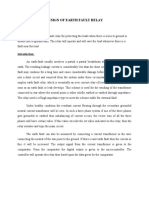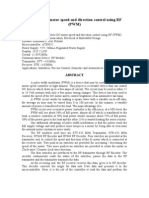0 ratings0% found this document useful (0 votes)
38 viewsVoltage Must Be Maintained Within Acceptable Levels: Reactive Power
Voltage Must Be Maintained Within Acceptable Levels: Reactive Power
Uploaded by
vallery1Voltage levels must be maintained between 95-105% of the nominal level to prevent equipment issues. Low voltages can cause motors to stall and capacitors to reduce output, while high voltages can damage insulation and trip transmission equipment. Reactive power does not travel far and is usually needed close to where it is used. A nearby source is better able to provide reactive power than a distant one. Reactive power supplies are also tied to delivering real power. A lack of reactive power can cause a blackout, as insufficient reactive power leading to voltage collapse has been a factor in major blackouts worldwide.
Copyright:
© All Rights Reserved
Available Formats
Download as DOCX, PDF, TXT or read online from Scribd
Voltage Must Be Maintained Within Acceptable Levels: Reactive Power
Voltage Must Be Maintained Within Acceptable Levels: Reactive Power
Uploaded by
vallery10 ratings0% found this document useful (0 votes)
38 views1 pageVoltage levels must be maintained between 95-105% of the nominal level to prevent equipment issues. Low voltages can cause motors to stall and capacitors to reduce output, while high voltages can damage insulation and trip transmission equipment. Reactive power does not travel far and is usually needed close to where it is used. A nearby source is better able to provide reactive power than a distant one. Reactive power supplies are also tied to delivering real power. A lack of reactive power can cause a blackout, as insufficient reactive power leading to voltage collapse has been a factor in major blackouts worldwide.
Original Description:
Reactive Power
Original Title
Reactive Power
Copyright
© © All Rights Reserved
Available Formats
DOCX, PDF, TXT or read online from Scribd
Share this document
Did you find this document useful?
Is this content inappropriate?
Voltage levels must be maintained between 95-105% of the nominal level to prevent equipment issues. Low voltages can cause motors to stall and capacitors to reduce output, while high voltages can damage insulation and trip transmission equipment. Reactive power does not travel far and is usually needed close to where it is used. A nearby source is better able to provide reactive power than a distant one. Reactive power supplies are also tied to delivering real power. A lack of reactive power can cause a blackout, as insufficient reactive power leading to voltage collapse has been a factor in major blackouts worldwide.
Copyright:
© All Rights Reserved
Available Formats
Download as DOCX, PDF, TXT or read online from Scribd
Download as docx, pdf, or txt
0 ratings0% found this document useful (0 votes)
38 views1 pageVoltage Must Be Maintained Within Acceptable Levels: Reactive Power
Voltage Must Be Maintained Within Acceptable Levels: Reactive Power
Uploaded by
vallery1Voltage levels must be maintained between 95-105% of the nominal level to prevent equipment issues. Low voltages can cause motors to stall and capacitors to reduce output, while high voltages can damage insulation and trip transmission equipment. Reactive power does not travel far and is usually needed close to where it is used. A nearby source is better able to provide reactive power than a distant one. Reactive power supplies are also tied to delivering real power. A lack of reactive power can cause a blackout, as insufficient reactive power leading to voltage collapse has been a factor in major blackouts worldwide.
Copyright:
© All Rights Reserved
Available Formats
Download as DOCX, PDF, TXT or read online from Scribd
Download as docx, pdf, or txt
You are on page 1of 1
REACTIVE POWER
Voltage must be maintained within Acceptable Levels
Under normal system conditions, both peak or off peak load conditions, the voltages need to be
maintained between 95% and 105% of the nominal.
-Low voltage conditions could result in equipment malfunctions:
Motor will stall, overheat or damage
Reactive power output of capacitors will be reduced exponentially
Generating units may trip.
High voltage conditions may:
Damage major equipment insulation failure.
Automatically trip major transmission equipment.
REACTIVE POWER LIMITATIONS
- Reactive power does not travel very far.
- Usually necessary to produce it close to the location where it is needed
- A supplier/source close to the location of the need is in a much better position to provide
reactive power versus one that is located far from the location of the need.
- Reactive power supplies are closely tied to the ability to deliver real or active power.
THE ABSENCE OF REACTIVE POWER
-Lack of reactive power causes a blackout-absence of electrical supply in a country.
-In reality such things have already happened a number of times. One of the reasons leading to a
blackout is reactive power that went out of the control.
-Insufficient reactive power leading to voltage collapse has been a causal factor in major
blackouts in the worldwide.
You might also like
- Test Your Motor Control IQDocument1 pageTest Your Motor Control IQboy2959No ratings yet
- RXTCD 4 Capacitor Voltage Supply Unit Combiflex: ApplicationDocument3 pagesRXTCD 4 Capacitor Voltage Supply Unit Combiflex: ApplicationKmj KmjNo ratings yet
- Model of MINI UPS SystemDocument38 pagesModel of MINI UPS Systemanand_sah51150% (4)
- 2017 Simulation of Three-Phase Transformerless Online UPS Using MATLAB-SIMULINK-IJAERDV04I0569640 PDFDocument7 pages2017 Simulation of Three-Phase Transformerless Online UPS Using MATLAB-SIMULINK-IJAERDV04I0569640 PDFTài Nguyễn Minh NhậtNo ratings yet
- Practical Guide to International Standardization for Electrical Engineers: Impact on Smart Grid and e-Mobility MarketsFrom EverandPractical Guide to International Standardization for Electrical Engineers: Impact on Smart Grid and e-Mobility MarketsNo ratings yet
- Fixing Low Voltage-Undervoltage ProblemsDocument7 pagesFixing Low Voltage-Undervoltage ProblemsAmany HamdyNo ratings yet
- Power Factor Correction by Pulse Width Modulated Switched Single CapacitorDocument26 pagesPower Factor Correction by Pulse Width Modulated Switched Single CapacitorDevendra SharmaNo ratings yet
- Project Reprt333Document49 pagesProject Reprt333dhirajsingh_avit83% (6)
- Grebe - Capacitor Switching and Its Impact On Power Quality Draft Paper 0000 PDFDocument7 pagesGrebe - Capacitor Switching and Its Impact On Power Quality Draft Paper 0000 PDFrmendozaing100% (1)
- Wireless DC Motor Speed and Direction Control Using Ir CommunicationDocument3 pagesWireless DC Motor Speed and Direction Control Using Ir CommunicationNeil PowellNo ratings yet
- Automatic Star Delta Starter Using RelayDocument4 pagesAutomatic Star Delta Starter Using RelayVishal Dagade0% (1)
- 1-5 Motor Protection RelayDocument16 pages1-5 Motor Protection RelayTeklit HailemariamNo ratings yet
- Three Phase Fault Analysis With Auto Reset For Temporary Fault and Trip ForDocument16 pagesThree Phase Fault Analysis With Auto Reset For Temporary Fault and Trip ForFirstLearnNo ratings yet
- 3 Phase Motor Programmable Controller Report 2Document3 pages3 Phase Motor Programmable Controller Report 2Solomon VargheseNo ratings yet
- Intro ProtectionDocument122 pagesIntro Protectionsantillan100% (1)
- PM172EH ModbusDocument54 pagesPM172EH ModbusRanajit Goswami100% (1)
- Motor Protection ToshibaDocument24 pagesMotor Protection ToshibaAriesFranandaPanjaitanNo ratings yet
- Z Source InverterDocument16 pagesZ Source InverterpradeepagrahariNo ratings yet
- Voltage Vs Var Control Small Hydro IDocument10 pagesVoltage Vs Var Control Small Hydro Ikcirrenwod100% (1)
- Digital Input Module SM 321 DI 16 X DC 24 V (6ES7321-1BH02-0AA0)Document3 pagesDigital Input Module SM 321 DI 16 X DC 24 V (6ES7321-1BH02-0AA0)Fabio CavalheiroNo ratings yet
- Automatic Transfer System Explained in DetailsDocument4 pagesAutomatic Transfer System Explained in DetailsSandro CuetoNo ratings yet
- Siemens - SolkorDocument32 pagesSiemens - SolkorKiliardt ScmidtNo ratings yet
- Understanding Power Cable Characteristics and ApplicationsDocument3 pagesUnderstanding Power Cable Characteristics and ApplicationsMehdi RabbaniNo ratings yet
- 1.AC DC InteractionDocument26 pages1.AC DC Interactionpvenky_kkdNo ratings yet
- Traffic Density Control ReportDocument44 pagesTraffic Density Control ReportSanjana SinghNo ratings yet
- Enerzio Product Catalog 2019-2020 New PDFDocument16 pagesEnerzio Product Catalog 2019-2020 New PDFHarvinder Singh HarryNo ratings yet
- A Summary of Protection RelaysDocument2 pagesA Summary of Protection RelaysarsalanhamidNo ratings yet
- New Microsoft Office Excel WorksheetDocument4 pagesNew Microsoft Office Excel WorksheetaubbakrNo ratings yet
- Vector Surge Relay - MRG20000Document20 pagesVector Surge Relay - MRG20000t_syamprasadNo ratings yet
- P220 PDFDocument12 pagesP220 PDFSatya VasuNo ratings yet
- Project - Arduino MPPT Solar Charge Controller - HackadayDocument43 pagesProject - Arduino MPPT Solar Charge Controller - Hackadaybazoka fransiskusNo ratings yet
- Gutor PXW Q410 053 ADocument4 pagesGutor PXW Q410 053 Acedar1015No ratings yet
- SeminarDocument25 pagesSeminarSwapnajitRayNo ratings yet
- PIC Training ReportDocument34 pagesPIC Training Reportapsingh8105No ratings yet
- EE33 Design of Earth Fault RelayDocument3 pagesEE33 Design of Earth Fault RelayMechWindNaniNo ratings yet
- Wireless DC Motor Speed and Direction Control Using RFDocument3 pagesWireless DC Motor Speed and Direction Control Using RFNidhin MnNo ratings yet
- Rocess Ower UPS System: Three Phase 10-125 kVADocument4 pagesRocess Ower UPS System: Three Phase 10-125 kVAFlorentino PonceNo ratings yet
- Circuit Breaker Specifications Mentioned On Its NameplateDocument13 pagesCircuit Breaker Specifications Mentioned On Its Nameplatearyo bimo surya putraNo ratings yet
- Avr 100s IngleseDocument65 pagesAvr 100s IngleseVedran GaćeNo ratings yet
- Star-Delta Motor StarterDocument16 pagesStar-Delta Motor StarterArifNo ratings yet
- Classification of RelaysDocument13 pagesClassification of RelaysGideon MoyoNo ratings yet
- EEC 214 Lecture 1Document34 pagesEEC 214 Lecture 1yhya TarekNo ratings yet
- IDC Course CalendarDocument1 pageIDC Course CalendarHu Hin AngNo ratings yet
- Three Phase Appliance ProtectorDocument40 pagesThree Phase Appliance ProtectorJeevan PreethuNo ratings yet
- Ansi Codes For Electrical SystemsDocument4 pagesAnsi Codes For Electrical SystemspmankadNo ratings yet
- Control and Instrumentation Training Report: Kariba South Power StationDocument12 pagesControl and Instrumentation Training Report: Kariba South Power Stationtrynosk100% (1)
- EE8251 Circuit Theory NotesDocument147 pagesEE8251 Circuit Theory Notessaravanakmar vNo ratings yet
- Dual Boost, Control, Current Control, ConclusionDocument6 pagesDual Boost, Control, Current Control, ConclusionHema LathaNo ratings yet
- 2015 Summer Model Answer PaperDocument30 pages2015 Summer Model Answer PaperRohit BariNo ratings yet
- Grid-Tie Transformerless Solar Inverter: Rpi M50A Operation and Installation ManualDocument76 pagesGrid-Tie Transformerless Solar Inverter: Rpi M50A Operation and Installation ManualLars MaesNo ratings yet
- Presentation On 132 KV Chambal G.S.S., JaipurDocument23 pagesPresentation On 132 KV Chambal G.S.S., JaipurDevendra Sharma100% (6)
- Generator Capability CurveDocument2 pagesGenerator Capability Curveaziz100% (1)
- LV Air Circuit Breakers M-PACT - M-PRODocument32 pagesLV Air Circuit Breakers M-PACT - M-PRO322399mk7086100% (1)
- Mas711 FLYGTDocument150 pagesMas711 FLYGTRafael GaleasNo ratings yet
- BCH April 16Document137 pagesBCH April 16Ramachandra SahuNo ratings yet
- Sap Final ReportDocument19 pagesSap Final ReportOm BankarNo ratings yet
- SCADA supervisory control and data acquisition Third EditionFrom EverandSCADA supervisory control and data acquisition Third EditionNo ratings yet
- Recitation 2: Equilibrium Electron and Hole Concentration From DopingDocument6 pagesRecitation 2: Equilibrium Electron and Hole Concentration From Dopingvallery1No ratings yet
- Chapter 1: General IntroductionDocument3 pagesChapter 1: General Introductionvallery1No ratings yet
- AC Voltage Measurement Using PIC16F877A MicrocontrollerDocument15 pagesAC Voltage Measurement Using PIC16F877A Microcontrollervallery1No ratings yet
- Automatic Power Factor Controller Using MicrocontrollerDocument29 pagesAutomatic Power Factor Controller Using Microcontrollervallery1100% (3)
- How To Update A Database From A DataSet Object by Using Visual BasicDocument10 pagesHow To Update A Database From A DataSet Object by Using Visual Basicvallery1No ratings yet
- Most Important Components of The AC System (ENG)Document2 pagesMost Important Components of The AC System (ENG)vallery1No ratings yet
- Free Course: Add, Update and Delete RecordsDocument3 pagesFree Course: Add, Update and Delete Recordsvallery1No ratings yet
- Free Course: Add, Update and Delete RecordsDocument3 pagesFree Course: Add, Update and Delete Recordsvallery1No ratings yet


































































